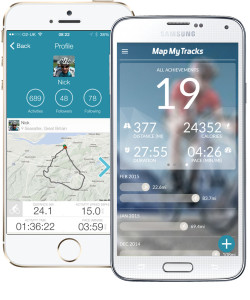You’ve recently discovered trail running, and love hitting the single track, but being new to the rigours of the pursuit, you struggle to stick to a schedule and keep motivation high. It may seem obvious – and sometimes it is, we just need a reminder like this one – but with a few mindful adjustments and some extra planning, you can enhance your newfound love of the trail running experience as well as overall performance. Here are some quick tips to help stick to healthy habits and hold yourself accountable as you fall more in love with the trail running lifestyle:
Organisation
If you are organised with your time, it is easier for you to stick to your running routines and habits. Create and follow a schedule that will help you stay on top of your daily trail runs. Each month, take some time to organise a calendar that sets up a running schedule, planned around your work hours and other obligations. And stick it somewhere obvious, that you can’t help but see each and every day – the fridge, inside the pantry, on your wardrobe door…
 Be mindful and realistic in how you align your schedule with the length/duration of your run, remembering that different trails of the same length can take vastly different lengths of time to cover, depending on their technicality and ascent.
Be mindful and realistic in how you align your schedule with the length/duration of your run, remembering that different trails of the same length can take vastly different lengths of time to cover, depending on their technicality and ascent.
If you plan on running a new trail, say of 10-20km give yourself an extra 20-40-minute cushion to account for any variance in difficulty.
Check the weather forecast to help you plan around any periods of extreme heat, heavy rain or other conditions that will deter you from getting outside and onto the trails. The plethora of digital devices available are helpful scheduling tools that will remind you of upcoming runs, once you sync it with your calendar. Set up your schedule on your iPhone SE’s calendar app, for instance, selecting a notification preference every time you enter in your “event.” Prior to your scheduled run, the calendar app will send a notification ping to be displayed on either your smartphone screen or your smartwatch.
Diet
Fuel your body with energy-boosting nutrients that will rev you up for your run and reinforce muscles. Trail running requires solid strength and agility drawing on perhaps more bodily reserves and capacities due to the uneven terrain, therefore it’s important that you’re always fueled up. Be mindful of your macro-nutrient consumption and the size of your meal portions, as these two dietary components can alter your immediate mental and physical states.
 The whole day’s meals should be planned to support the energy you’ll need for a successful trail run. An example of an ideal day of eating is: protein and carbs for breakfast (i.e., eggs, yogurt and toast), protein and fibre for lunch (i.e., steak salad), carbohydrates for a pre-run snack (i.e., health bar) and protein and fibre for dinner (i.e., chicken and steamed vegetables). Fibre will help your body’s digestive system stay on track, so you don’t feel weighed down or bloated, which may deter you from mastering the hilly terrain. Carbohydrates give you quick energy, therefore are a great pre-run fuel source. Protein provides more sustained energy and helps preserve and build muscle. Stay on track with your dietary needs through a smartphone app like MyPlate, which lets you create macro nutrient goals and log your meals for future review and performance analysis.
The whole day’s meals should be planned to support the energy you’ll need for a successful trail run. An example of an ideal day of eating is: protein and carbs for breakfast (i.e., eggs, yogurt and toast), protein and fibre for lunch (i.e., steak salad), carbohydrates for a pre-run snack (i.e., health bar) and protein and fibre for dinner (i.e., chicken and steamed vegetables). Fibre will help your body’s digestive system stay on track, so you don’t feel weighed down or bloated, which may deter you from mastering the hilly terrain. Carbohydrates give you quick energy, therefore are a great pre-run fuel source. Protein provides more sustained energy and helps preserve and build muscle. Stay on track with your dietary needs through a smartphone app like MyPlate, which lets you create macro nutrient goals and log your meals for future review and performance analysis.
Motivation and Training
Don’t let your daily runs become mundane, as you’ll be less motivated to actually go on them. Create challenges for yourself that will push you to improve your trail running PRs and stick to you healthy habit. Gauge your running speed through a smartphone or smartwatch health app that will log your miles, speed, elevation gain and geographical route. Things like Map My Tracks will provide you with the data and stats that you’ll need in order to set your goals. This app’s GPS gives you an accurate reading and lets you seamlessly log your routes.
 First, work on improving your running speed on one specific trail, as you need a ‘control’ or baseline for an accurate measurement of speed patterns and improvement. The next challenge to set for yourself is to maintain your average speed on different trail terrains that have varying elevation gains. You will feel your body develop more muscles and respond differently to each trail, which will make you a more versatile runner. While frequent training is important, you must also exercise moderation and integrate recovery periods.
First, work on improving your running speed on one specific trail, as you need a ‘control’ or baseline for an accurate measurement of speed patterns and improvement. The next challenge to set for yourself is to maintain your average speed on different trail terrains that have varying elevation gains. You will feel your body develop more muscles and respond differently to each trail, which will make you a more versatile runner. While frequent training is important, you must also exercise moderation and integrate recovery periods.
Trail running, especially hilly and technical runs, will strain your body and push it to its limits. Don’t over tax yourself by only hitting the most difficult trails multiple times a week — sprinkle in some beginner trail routes and road running to give your body a little recovery time. You should rotate your running terrains between groomed trails, rugged trails and the road.









